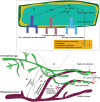Trichoderma spp. Genes Involved in the Biocontrol Activity Against Rhizoctonia solani
- PMID: 35694310
- PMCID: PMC9174946
- DOI: 10.3389/fmicb.2022.884469
Trichoderma spp. Genes Involved in the Biocontrol Activity Against Rhizoctonia solani
Abstract
Rhizoctonia solani is a pathogen that causes considerable harm to plants worldwide. In the absence of hosts, R. solani survives in the soil by forming sclerotia, and management methods, such as cultivar breeding, crop rotations, and fungicide sprays, are insufficient and/or inefficient in controlling R. solani. One of the most challenging problems facing agriculture in the twenty-first century besides with the impact of global warming. Environmentally friendly techniques of crop production and improved agricultural practices are essential for long-term food security. Trichoderma spp. could serve as an excellent example of a model fungus to enhance crop productivity in a sustainable way. Among biocontrol mechanisms, mycoparasitism, competition, and antibiosis are the fundamental mechanisms by which Trichoderma spp. defend against R. solani, thereby preventing or obstructing its proliferation. Additionally, Trichoderma spp. induce a mixed induced systemic resistance (ISR) or systemic acquired resistance (SAR) in plants against R. solani, known as Trichoderma-ISR. Stimulation of every biocontrol mechanism involves Trichoderma spp. genes responsible for encoding secondary metabolites, siderophores, signaling molecules, enzymes for cell wall degradation, and plant growth regulators. Rhizoctonia solani biological control through genes of Trichoderma spp. is summarized in this paper. It also gives information on the Trichoderma-ISR in plants against R. solani. Nonetheless, fast-paced current research on Trichoderma spp. is required to properly utilize their true potential against diseases caused by R. solani.
Keywords: R. solani; Trichoderma spp.; antibiosis; competition; genes; induced systemic resistance; mycoparasitism.
Copyright © 2022 Abbas, Mubeen, Zheng, Sohail, Shakeel, Solanki, Iftikhar, Sharma, Kashyap, Hussain, del Carmen Zuñiga Romano, Moya-Elizondo and Zhou.
Conflict of interest statement
The authors declare that the research was conducted in the absence of any commercial or financial relationships that could be construed as a potential conflict of interest.
Figures




References
-
- Abdel-lateif K. S. (2017). Trichoderma as biological control weapon against soil borne plant pathogens. Afr. J. Biotechnol. 16, 2299–2306. doi: 10.5897/ajb2017.16270 - DOI
-
- Ahmad J. S., Baker R. (1987). Rhizosphere competence of Trichoderma harzianum. Phytopathology 77, 182–189. doi: 10.1094/phyto-77-182 - DOI
-
- Aidemark M., Tjellström H., Sandelius A. S., Stålbrand H., Andreasson E., Rasmusson A. G., et al. . (2010). Trichoderma viride cellulase induces resistance to the antibiotic pore-forming peptide alamethicin associated with changes in the plasma membrane lipid composition of tobacco BY-2 cells. BMC Plant Biol. 10, 1–13. doi: 10.1186/1471-2229-10-274 - DOI - PMC - PubMed
-
- Ajayi-Oyetunde O. O., Bradley C. A. (2018). Rhizoctonia solani: taxonomy, population biology and management of Rhizoctonia seedling disease of soybean. Plant Pathol. 67, 3–17. doi: 10.1111/ppa.12733 - DOI
Publication types
LinkOut - more resources
Full Text Sources
Miscellaneous

